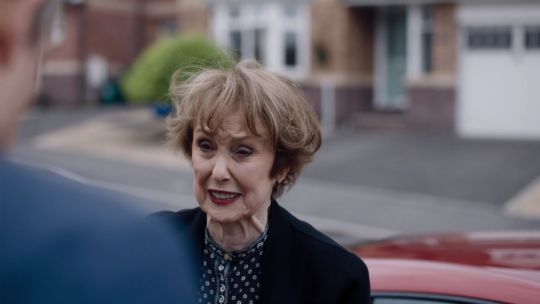#and potentially a 'greater chance of keeping up with Mycroft's train of thought because they too have a unique perspective of the world' bo
Note

[[ One of Will's co-workers totally filled this chart and left it on Mycroft's temporary desk xD ]]


"How very interesting."
#collidingxworlds#Will may not tick the 'well above average intelligence' box#but he does tick the not included 'fascinating mind' box#and potentially a 'greater chance of keeping up with Mycroft's train of thought because they too have a unique perspective of the world' bo#(also ngl Mycroft would like his dogs)#(he'd grumble about them but then pet them when no one is looking)
7 notes
·
View notes
Text
THE SEVEN-PER-CENT SOLUTION
In the collective imagination Holmes wears a deerstalker (not true), wears a cape (maybe), uses a magnifying glass (often), smokes a pipe (very willingly), is a heartless machine (only at a first glance ) and is a drug addict.
His habit of drugs, consolidated in the Canon, often, probably in order not to offend current morals, has been neglected by subsequent adaptations that have become fossilized on stereotyped and even not completely true characteristics.
The attitude towards drugs has changed over the past 130 years, to tell the truth, it has also changed during the course of the Canon itself. Sherlock Holmes will stop his vicious habit at some point.
You can’t even blame Doyle for having started it, substances such as morphine and coacaine, recently synthesized (1803 morphine, 1855 cocaine) were used in the medical field, were also given to children, and for voluptuous purposes. The same heroine, the last born, sees the light in the pharmaceutical field in the Bayer company. Toning drinks whith cocaine were common, the same CocaCola contained it in its first formulation. Cocaine was above all much appreciated by intellectual circles as it gave the feeling of being able to open the mind and stimulate mental processes. No wonder if a man like Sherlock Holmes may have wanted to linger in such a vice.
However, the negative effects of drug intake were gradually more evident. A doctor like Doyle couldn’t ignore the course of events and Watson's position on drugs became rigid, even Holmes himself gave up on this practice (MISS).
The use of drugs wasn’t seen as pathological, a traumatic cause wasn’t sought in the habit of indulging. So wanting to see something more behind Holmes's addiction could just be, perhaps, a distortion by what we know and feel now. However, even in the Canon the use of drugs is associated with a sense of abandonment and the consequent search for comfort (SIGN).
This is one of those rare glimpses in which the mask of Holmes slips and he appears as a sensitive man. Ignoring his habit takes away a chance to make the detective a creature less chilly and more human, imperfect. No wonder then that the two adaptations that for first tried to see Sherlock Holmes as the human being behind the detective didn’t leave out this habit and tried to suggest that there was something more behind it. I'm talking about The private life of Sherlock Holmes and The Seven-Percent Solution. But both adaptations, I must say, make promises they don’t maintain. We don’t know much more about Sherlock Holmes' private life after seeing the film (I have not read the book), it is suggested that between him and Watson there is more than a friendship, or at least that Holmes would like more, but then they missed tyself in a maze of international plots, fatal woman and submarine. But The Seven- Percent Solution is perhaps, in my opinion, even a greater disappointment.
Spoilers under the cut.
The assumptions are excellent, brings together Holmes' drug habit, which appears much more obvious and out of control, and Sigmund Freud. A step not too bold. The alienist himself had suffered from cocaine addiction and had lost a friend for the same reason. So if at the beginning he had praised the virtues, using it for his patients, he had come to recognize the danger of it. It seems therefore possible , if not probable, a connection between the two minds. Fascinating meeting considering a similar approach to the method and a complete difference in the result. Freud uses to probe the inner world the same techniques that Holmes uses to navigate the surface and untangle the nodes of sensitive reality. The rational man meets the man who "invented" the unconscious and the reason for their encounter is cocaine. Potentially dynamite. But if attention is paid to detoxification, little is told, if not hastily and superficially (a few lines) of the reason that may have prompted Holmes to indulge in a potentially deadly vice. In the book as in the movie attention is diverted by a case and if in the book it sees a woman at the center of a political intrigue that heralds the great war ( east wind), in the movie is further simplified and reduced to an operetta show, with barons, pasha, and a beautiful woman whom Holmes eventually falls in love with (sigh). In the book Watson shows a sincere affection for Holmes and Holmes despite his difficulties, is sensibly moved and obviously in need of his friend. There is Mary Morstan but, to the delight of the wary reader, she refers to Watson always (and many times, too many) calling him Jack. Particularly in a text in which Watson admits to having tampered with and falsified some of his work is a rather sugary detail. Watson saves Holmes' life by trickery, dragging him to Vienna to meet Freud. It doesn’t pass unnoticed, however, that the necessity of saving his life comes to light because Holmes' drug habit has considerably worsened since the doctor married. In the movie all this is less obvious, between the two it is difficult to see a real bond. Holmes seems, throughout the movie, a thinking machine (in the grip of delirium induced by cocaine, but still anaffective), we see he melt and soften only at the end while he smiles at the beautiful woman who they have decided to match to him (do you understand that I'm nervous?). Given that he has just turned away from Watson without any thought, on the part of both to be true, Watson seems more concerned about his readers who will remain without adventures, it is definitely annoying.
But I'm also annoying because I'm talking about all this without explaining the plot. Actually there are elements in the book, and partly also in the movie, terribly interesting from "our" point of view. I think one of the funniest elements of what we're doing here, is digging to find all those little details, steps, that, possibly, brought the Moffits to do what they did, how they did it. And I think this book / movie, like The Private Life of Sherlock Holmes, was a huge inspiration (maybe they even said it, I'm not good at keeping track of anything, even less interviews). And perhaps this character of incompleteness that combines the two works has been a stimulus.
The book opens with a preface by the author who pretends to have come in possession of a ( another) unpublished Watson’s script. A text dictated to a complacent typist when, at the end of his life, the doctor found himself alone, dead Holmes for ten years, in a nursing home (and here we can all cry crying in a corner). In the typescript Watson tells what really was behind the Final Problem. He also promises to tell the background to The Empty Houses, but unfortunately this is another promise he doesn’t keep. We are told that Holmes, left alone by Watson, has lost himself in an abyss of drug binges. A worried Mrs Hudson asks Watson for help, being afraid to enter Holmes' rooms, evidently prey of delirium. In the movie we can see him locked in home, room in an absolute disorder, nervously brandishing a gun in his hand. (say hello to Billy).

Apparently Holmes is totally obsessed with a certain Professor Moriarty, whose name Watson had heard only a few times and always when Holmes was high.
Holmes says that this gruesome individual is behind every crime perpetrated in recent years, the spider in the center of the web, the Napoleon of crime etc, etc.
Back home, Watson finds Moriarty in person waiting for him. He turns out to be a poor little man, former tutor of mathematics of the young Holmes. The man is worried because Holmes pursues him, following him physically and threatening him by letter. He admits at the same time of being attached to the two Holmes, that his time in their home was pleasant, until the moment of the tragedy. However, he refuses to elaborate the subject.
Watson then has proof that his friend is just about to lose his reason first, and his life then.
He find, the same day, thanks to the incomparable Stamford to which he had the good sense to ask for help, a newspaper article that talks about a certain Dr. Freud expert in disorders related to cocaine.
He therefore decides that at all costs he must induce Holmes to reach Vienna. Not being able to come up with a valid plan, he turns to Mycroft who has the "brilliant" idea of convincing Professor Moriarty to go to Vienna so that Sherlock is induced to follow him (it took a genius for a plan so elaborate ... .but again, we want things to be smarter than they are). Holmes in his ravings had thrown out of a vanilla extract in front of the professor's house, in this way he’s now able to chase, with the help of trusty Toby, the traces of Moriarty from London to Vienna ...
Once in the Austrian capital Holmes discovers the deception and is taken care of by Freud, who through hypnosis takes care to make him overcome the physical difficulties of addiction to cocaine. Holmes is obviously enraged with Watson who stoically endures all kinds of insults. Until the day when, to calm his friend, he hits him so hard that he loses his knowledge.
Once detoxed Holmes falls into a depressive state, from which he’s recover only thanks to his violin and a new case. Despite being in the house of Freud we never facing with the demon behind the vice, let alone the tragedy referred by Moriarty, that apparently never is mentioned.
The story then follows the development of the case, ending with a spectacular pursuit in a train. Pleasant, but seeing Freud used to shovel coal and not know anything about Holmes is a bit frustrating. In the movie is even worse, the case is silly, there is a ridiculous scene in which the three are attacked by a pack of dressage horses completely out of control (why, how!? ... maybe there is a Freudian allusion behind that I don’t want to investigate, or at least I hope) or another improbable in which the woman leaves as a trace to follow lilies from the very long stem. Holmes takes a while to notice the first, and a dumb Watson wonders if by accident they have accidentally escaped from the woman's hair. I'll not dwell on the scene in a brothel where Holmes continues to have to draw the attention of Watson who was drooling around with an imbecile expression.
At the end of both cases, Freud as a reward for the assistance provided, asks to hypnotize for the last time Holmes. Finally in this circumstance he ask about the famous tragedy that has disturbed Holmes' childhood by making that his future fixations was shaped on Professor Moriarty. It turns out that Holmes's mother had betrayed his father, which is why he ended to kill her and her lover. In the movie in a more simplistic, but also more direct, it is revealed that the mother's lover was none other than the tutor of the boys, Moriarty. In the book the path is more tortuous, Moriarty is guilty only of having told what had happened, to the young Sherlock. He becomes the scapegoat of his trauma, although he participated in a tangent way, probably in the absence of the real protagonists. This episode would also be the cause of Holmes's distrust of women.
This is another of those stereotypical characteristics that are given to Sherlock Holmes that although almost never expressing appreciation for the female gender, has at heart their health and happiness, in its own way, much more than most of the men who trample this land. He simply doesn’t love them, but this is not called misogyny, it's called homosexuality.
At the end of the story Holmes decides not to return to London with Watson, but to allow himself time to heal better. His intention is to earn a living with the violin under the false name of Sigerson. Perhaps even to deepen the knowledge of what it really is, but this is something that will happen,maybe, off the screen.
And maybe that's what the Moffits are trying to do is show what this book / movie, despite having courageous premises, didn’t know / wanted to do.
Meyer, the author, in fact, as a good Sherlockian, had, ably bringing forth the Great Game, putting together theories already circulated among Holmes fans.
The idea of child tragedy, of mother's betrayal, is taken by Trevor Hall who in 1969 theorized it in the Holmes-Ten Literary Study. Even the idea of paranoia from cocaine, which causes hallucinations on an innocent Professor Moriarty is taken elsewhere. Fred Musto in 1968 theorized that the figure of the criminal genius Moriarty was nothing more than a paranoid hallucination of Holmes while trying to detox himself (paranoia moriartii).
Moreover, the difference in "thickness" between the normal villains of Sherlock Holmes and the others of the Canon is so abysmal that no one can blame the man for thinking about it.
Extrapolating from TFP it seems even evident. (x)
"You have probably never heard of Professor Moriarty?" he said. "Never." "Aye, there's the genius and the wonder of the thing!" He cried. "The man pervades London, and no one has heard of him. "
Wanting to study the man behind the detective seems to me sensible to have been inspired by such premises.
Sherlock's dependence throughout the series is shown in an escalation that can’t be random. It starts from simple patches of nicotine, which could be the equivalent of cocaine used as medicine, to ended in real binges of drugs.


The hypothesis of a Sherlock who, in the grip of a delirium, an allegorical (x) delirium induced by drugs, perhaps so serious that it may have even left him in a coma, retraces moments of his life making to play to more or less innocent characters the part of villains seem to have deeper roots than they seem to appear.
Parts of the book and the movie seem already seen (or better, reviewed) in Sherlock.
From Mrs. Hudson asking John for help,


Sherlock closed in 221b in the grip of delirium whit a gun,


Moriarty who suddenly appears in the detective's thoughts, replacing something that already frightened him: the mastiff in THOB and in the movie when during one of the dreams in which Holmes falls prey during detoxification, Moriarty's face overlaps that of the SPEC snake.


Watson hits Holmes with more force than he wanted.


Another interesting idea is the scene in which, always during the detox, a ferocious mastiff leaves a closet.


I don’t know if there may be any subtext here, even if I suspect that dogs were related to homosexuality in the Canon itself, but it is a cue from which the Moffits may have departed.
A curious case about dogs is also the choice of Toby's "interpreter". Dog not of breed both in the Canon and in the book, in the movie it has this aspect and is perhaps the living being towards which Holmes demonstrates greater affection.


Holmes the first time he finds himself in front of Freud accuses him of being just Moriarty disguised with a beard and a ridiculous operetta accent. Even in TFP we have someone disguised (this time for real) as a psychoanalyst and with a ridiculous operetta accent.

Another interesting fact is that Holmes speaks of Moriarty as the snake of Eden. Plausible considering that in the movie they make him the lover of the mother, but it is something that we also see in Sherlock.

So it's safe to ask who our Moriarty really could be. Too young to be the lover of the mother, or of the father if the clues collected by @sagestreet lead us to the right direction. Moreover here is the mother to become "incredibly monstrous". Mathematic genius is also the mother.
We know nothing about Moriarty, they do not give him any background. In Doyle we know his origins, his studies, his career and his profession. In Sherlock we only know from TFP that he has a brother of whom he has always been jealous and who was responsible for the death of Carl Powers. We only know that he is a criminal genius, not why or how he became like this. More or less the same things we know about Sherlock Holmes in the Canon.
@possiblyimbiassed @ebaeschnbliah @gosherlocked @sarahthecoat @sagestreet @loveismyrevolution
#the seven-per-cent solution#moffits background#sherlock addiction#holmes and freud#the man behind the detective
70 notes
·
View notes